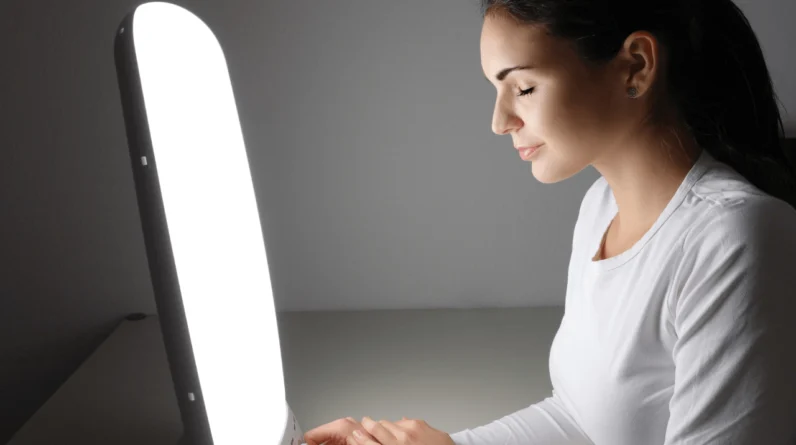
If you live in the northern hemisphere, you know how hard it can be to lose more sunlight day after day – for months.
You head to work in the dark and by the time you get home, it’s dark again. This can take a huge toll on your mental health! This is where Seasonal Affective Disorder (Or the winter blues) begins to affect a lot of us – and sometimes we don’t even notice it creeping up on us.
Losing the benefits of that natural sunlight means you can become vitamin D deficient – which comes with all kinds of issues. A light therapy lamp can help you fill the gap by mimicking natural outdoor light – and it comes with some pretty helpful benefits.
In this article, we’ll examine this topic a little further.
- What are light therapy lamps?
- Does light therapy for depression actually work?
- How else can these lamps help?
5 Awesome Benefits of Light Therapy Lamps
Light therapy lamps are also known as vitamin D lamps, light boxes and SAD lamps.
1. Improved Energy & Better Sleep
Doctor Andrew Weil states,
“Shorter daylight hours can affect sleep, productivity, and state of mind. Light therapy, also known as phototherapy, may help. It uses light boxes emitting full-spectrum light to simulate sunlight.”
Research indicates how the rate of production of serotonin is directly linked to exposure to direct sunlight. Serotonin is associated with improved mood, sleep regulation, and enhanced energy.
A lot of people feel super drained and down in the winter due to the lack of this vital hormone.
Yet, regular use of a seasonal depression lamp can help you and your body overcome these pitfalls. Even just 20 minutes of light therapy can help make improvements in relation to your energy and sleep!
2. Improved Mood
Similar to how vitamin D lamps help improve energy and sleep, they also boost your mood.
This is particularly useful for those who experience seasonal depression.
So, how does this work?
As you might have already guessed, serotonin plays a part. Serotonin is known for regulating mood, with low levels being linked to depression and anxiety.
When exposed to light, your body amps up serotonin production, helping you feel a bit happier.
As previously mentioned, light therapy also contributes to better sleep. This can also significantly enhance your mood.
Related Article: 4 Signs of Depression You May Not Recognize
3. Better Bone Health
We can get vitamin D from food, but the majority of the vitamin D we get is from direct sunlight hitting our skin. Without as much sunlight, as happens in the winter months, many of us face deficiencies, which can contribute to a variety of health issues.
One of the main functions that vitamin D has in the body is helping it absorb phosphorus and calcium. These two minerals are essential for building and maintaining healthy bones.
While vitamin D supplementation can help, light therapy helps your body naturally make this vitamin, as it usually would, ensuring your bones stay in tip-top shape.
4. Enhanced Cognitive Function
Research has shown seasonal affective disorder lamps to help improve cognition, including concentration, focus, and memory.
It’s thought to do this by:
- increasing blood flow to the brain
- enhancing energy production
- providing neuroprotective effects
- reducing inflammation
There’s even evidence showing how light therapy can help potentially prevent dementia and Alzheimer’s Disease. In other words, you aren’t just giving your health a boost now, but also providing your future self some health protection down the road.
5. Decreased Stress
Surprisingly, some stress is actually good on the body.
Yet, we live in a very stressful world and most of us don’t need more added to our lives. In fact, most of us would probably prefer to reduce it!
If this sounds like you, a seasonal depression lamp might be exactly what you need. It can help decrease stress, as well as reduce inflammation — decreasing stress in the body even further.
Related Article: Winter Blues? Practical Tips For Beating Winter Sadness
How to Start Light Therapy
First up, you’ll want to purchase a vitamin D lamp.
Usually, an intensity of about 10,000 lux is recommended, especially for combatting depression. For the best results, use the lamp first thing in the morning. This falls in line with your natural circadian rhythm.
- Ensure the lamp is about 16 to 24 inches away from your face
- Expose yourself to it for about 20 to 30 minutes at the same time each day
Make sure, during use, that you don’t look directly at the light as this can impact your vision (Just like you shouldn’t look directly at the sun).
Many people notice improvements within a week or two. Monitor how you feel by tracking your mood and energy levels in a journal. This can help you understand if it’s working, as well as provide incentive for further use.
If you want to check out light therapy lamps:
Disclosure: As an Amazon Associate, we earn a commission when you click the link and finalize a purchase (At zero cost to you.). We participate in programs like these to keep providing our readers free daily motivational content.
Precautions to Be Aware of When Using Light Therapy Lamps
While light therapy lamps used for seasonal affective disorder are generally considered safe, due to the fact they don’t give off UV radiation like sun lamps in a tanning bed, there are still precautions to consider.
Make sure you follow the best practices as listed above, and pay attention to the manufacturer’s directions as well.
If you have a medical condition that can increase light sensitivity, such as lupus, macular degeneration or connective tissue disorders, speak to your doctor before trying this treatment.
There is also a risk of a manic episode in people with bipolar disorder, so of course check with your physician first to be safe.
Use the Power of Light
With technology, we tend to underestimate the power and benefits of natural sunlight. However, technology also allows us to mimic this when we’re unable to obtain enough sunlight due to the changing of the seasons.
A seasonal affective disorder lamp can help you overcome that winter hump. In fact, light therapy for depression has become a prominent and well-known treatment method, with many scientific studies backing up its use and effectiveness.
Try it out! Add it to your regular wellness regime. Chances are, you’ll notice a difference. After all, winter doesn’t have to be hard. It can be fun!
Find what works for you and get out there in that beautiful winter wonderland, appreciating the season to the fullest.
Read Next: 10 Ways to Improve Your Mental Well-Being Right Now
Editor’s note: This article was originally published Dec 31, 2021 and has been updated to improve reader experience.







